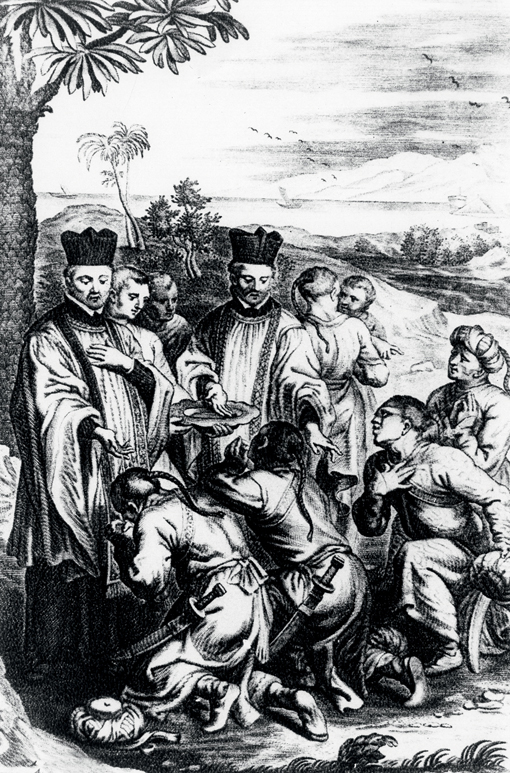A History of World Societies:
Printed Page 523
A History of World Societies Value
Edition: Printed Page 521
Chapter Chronology
The Catholic Reformation
In response to the Protestant Reformation, by the 1530s the papacy was leading a movement for reform within the Roman Catholic Church. After about 1540 no new large areas of Europe, other than the Netherlands, became Protestant. Many historians see the developments within the Catholic Church after the Protestant Reformation as two interrelated movements, one a drive for internal reform linked to earlier reform efforts and the other a Counter-Reformation that opposed Protestantism spiritually, politically, and militarily.

Jesuits in China This European image depicts early Jesuit missionaries baptizing converts in south China. (Archiv Gerstenberg — ullstein bild/The Granger Collection, NYC — All rights reserved.)
Under Pope Paul III (pontificate 1534–1549), the papal court became the center of the reform movement. Paul III established the Supreme Sacred Congregation of the Roman and Universal Inquisition, often called the Holy Office, with judicial authority over all Catholics and the power to imprison and execute. He also called a general council of the church, which met intermittently from 1545 to 1563 at the city of Trent. The Council of Trent laid a solid basis for the spiritual renewal of the Catholic Church. It gave equal validity to the Scriptures and to tradition as sources of religious truth and tackled problems that had disillusioned many Christians. Bishops were required to live in their dioceses and to establish a seminary for educating and training clergy. Finally, it placed great emphasis on preaching to and instructing the laity. For four centuries the Council of Trent served as the basis for Roman Catholic faith, organization, and practice.
Just as seminaries provided education, so did new religious orders, which aimed to raise the moral and intellectual level of the clergy and people. The Ursuline (UHR-suh-luhn) order of nuns, founded by Angela Merici (1474–1540), attained enormous prestige for its education of women. After receiving papal approval in 1565, the Ursulines rapidly spread to France and the New World.
Another important new order was the Society of Jesus, or Jesuits. Founded by Ignatius Loyola (1491–1556) in 1540, this order played a powerful international role in strengthening Catholicism in Europe and spreading the faith around the world. While recuperating from a severe battle wound, Loyola studied religious books and decided to give up his military career and become a soldier of Christ. Recruited primarily from wealthy merchant and professional families, the Society of Jesus developed into a highly centralized organization. They established well-run schools to educate the sons of the nobility as well as the poor. The Jesuits achieved phenomenal success for the papacy and the reformed Catholic Church, carrying Christianity to South and Central America, India, and Japan before 1550 and to Brazil, North America, and the Congo in the seventeenth century. Within Europe the Jesuits brought almost all of southern Germany and much of eastern Europe back to Catholicism. Also, as confessors and spiritual directors to kings, Jesuits exerted great political influence.
